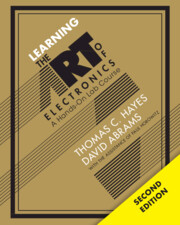Book contents
- Learning the Art of Electronics
- Learning the Art of Electronics
- Copyright page
- Dedication
- Contents
- Preface to the Second Edition
- Preface to the First Edition
- Overview, as the Course begins
- Part I Analog: Operational Amplifiers and their Applications
- Part II Analog: Discrete Transistors
- Part III Analog: Operational Amplifiers and their Applications
- Part IV Digital: Gates, Flip-Flops, Counters, PLD, Memory
- 14N Logic Gates
- 14L Lab: Logic Gates
- 14S Supplementary Notes: Digital Jargon and Logic Interfacing
- 14W Worked Examples: Logic Gates
- 14O Online Content: Logic Gates
- 15N Introduction to Programmable Logic
- 15L Lab: Programmable Logic
- 15S Supplementary Notes: The WebFPGA
- 15W Worked Examples: Programmable Logic
- 15O Online Content: Programmable Logic
- 16N Flip-Flops
- 16L Lab: Flip-Flops
- 16S Supplementary Notes: Flip-Flops
- 17N Counters
- 17L Lab: Counters
- 17S Supplementary Notes: Digital Debugging
- 17W Worked Examples: Applications of Counters
- 17O Online Content: Counters
- 18N Memory
- 18L Lab: Memory
- 18S Supplementary Notes: Memory Blocks
- 19N Finite State Machines
- 19L Lab: Finite State Machines
- 19W Worked Examples: Finite State Machines
- Part V Digital: Analog–Digital, PLL, Digital Project Lab
- Part VI Microcontrollers
- Book part
- Index
15N - Introduction to Programmable Logic
from Part IV - Digital: Gates, Flip-Flops, Counters, PLD, Memory
Published online by Cambridge University Press: 18 March 2025
- Learning the Art of Electronics
- Learning the Art of Electronics
- Copyright page
- Dedication
- Contents
- Preface to the Second Edition
- Preface to the First Edition
- Overview, as the Course begins
- Part I Analog: Operational Amplifiers and their Applications
- Part II Analog: Discrete Transistors
- Part III Analog: Operational Amplifiers and their Applications
- Part IV Digital: Gates, Flip-Flops, Counters, PLD, Memory
- 14N Logic Gates
- 14L Lab: Logic Gates
- 14S Supplementary Notes: Digital Jargon and Logic Interfacing
- 14W Worked Examples: Logic Gates
- 14O Online Content: Logic Gates
- 15N Introduction to Programmable Logic
- 15L Lab: Programmable Logic
- 15S Supplementary Notes: The WebFPGA
- 15W Worked Examples: Programmable Logic
- 15O Online Content: Programmable Logic
- 16N Flip-Flops
- 16L Lab: Flip-Flops
- 16S Supplementary Notes: Flip-Flops
- 17N Counters
- 17L Lab: Counters
- 17S Supplementary Notes: Digital Debugging
- 17W Worked Examples: Applications of Counters
- 17O Online Content: Counters
- 18N Memory
- 18L Lab: Memory
- 18S Supplementary Notes: Memory Blocks
- 19N Finite State Machines
- 19L Lab: Finite State Machines
- 19W Worked Examples: Finite State Machines
- Part V Digital: Analog–Digital, PLL, Digital Project Lab
- Part VI Microcontrollers
- Book part
- Index
Summary
In addition, packaged logic gates are low density, typically containing only a few gates.1 That means any reasonably complex digital systems might need tens or hundreds of DIP packages. Because signals have to travel between packages, systems built with discrete logic are limited in speed as well.
- Type
- Chapter
- Information
- Learning the Art of ElectronicsA Hands-On Lab Course, pp. 620 - 635Publisher: Cambridge University PressPrint publication year: 2025

